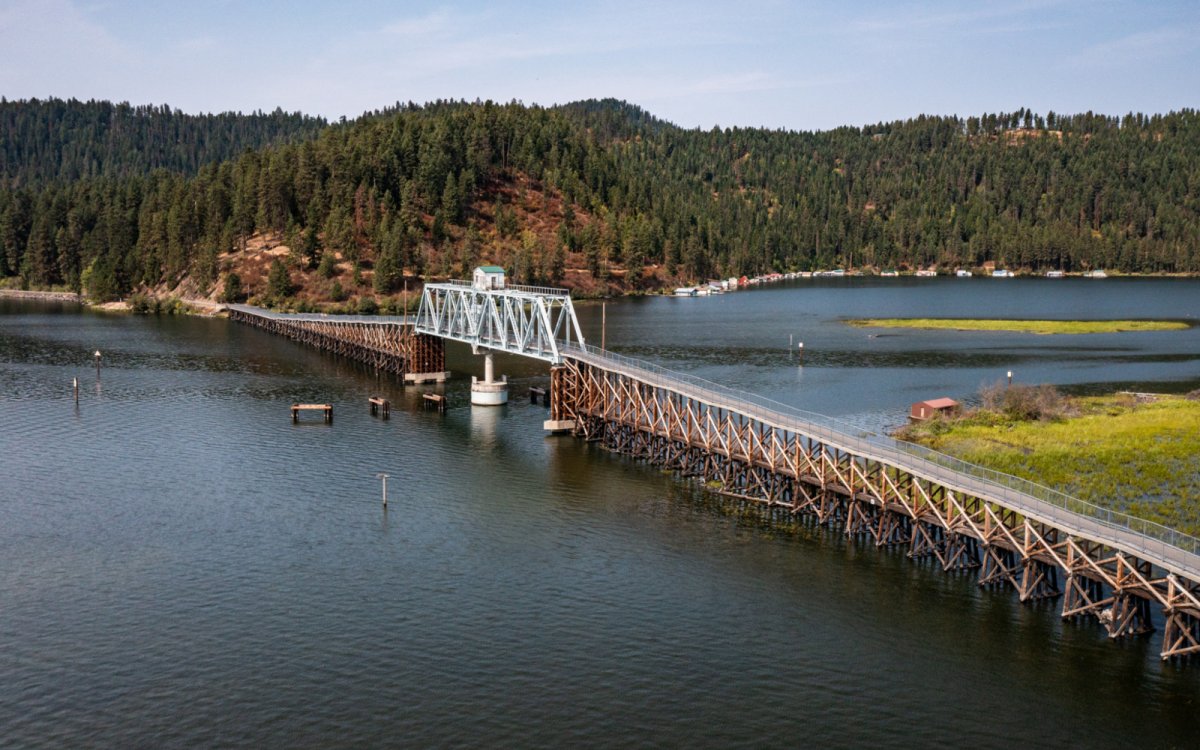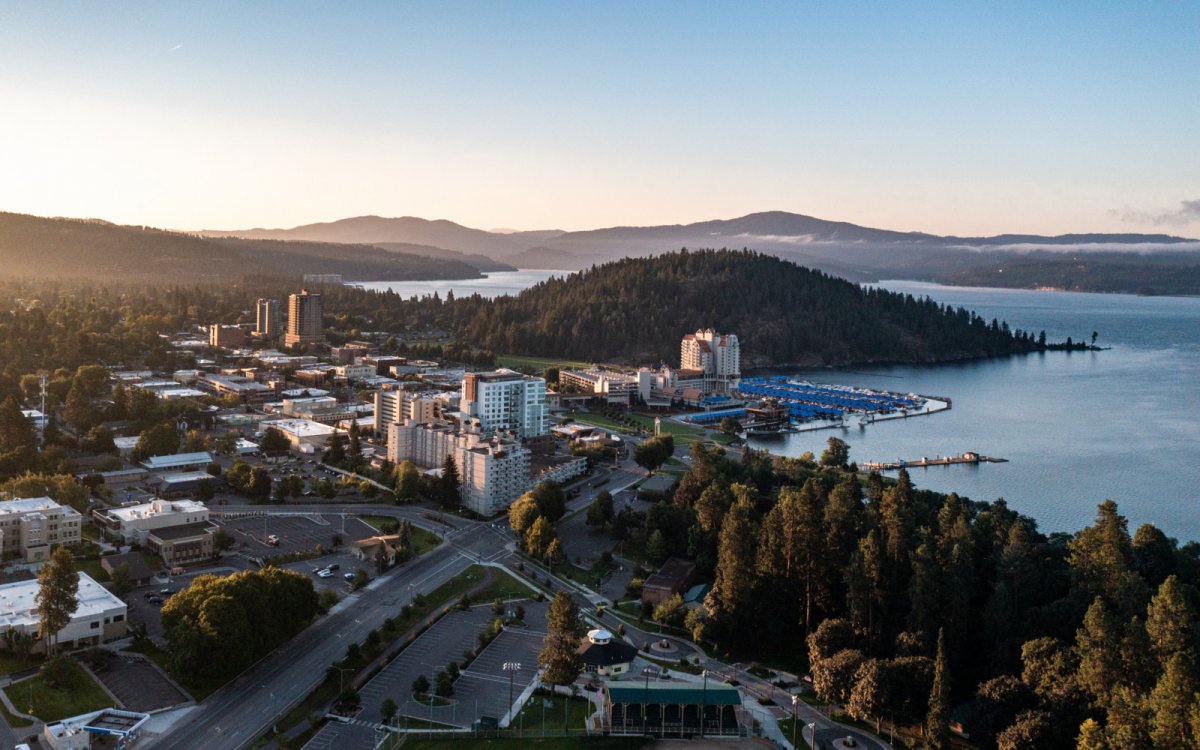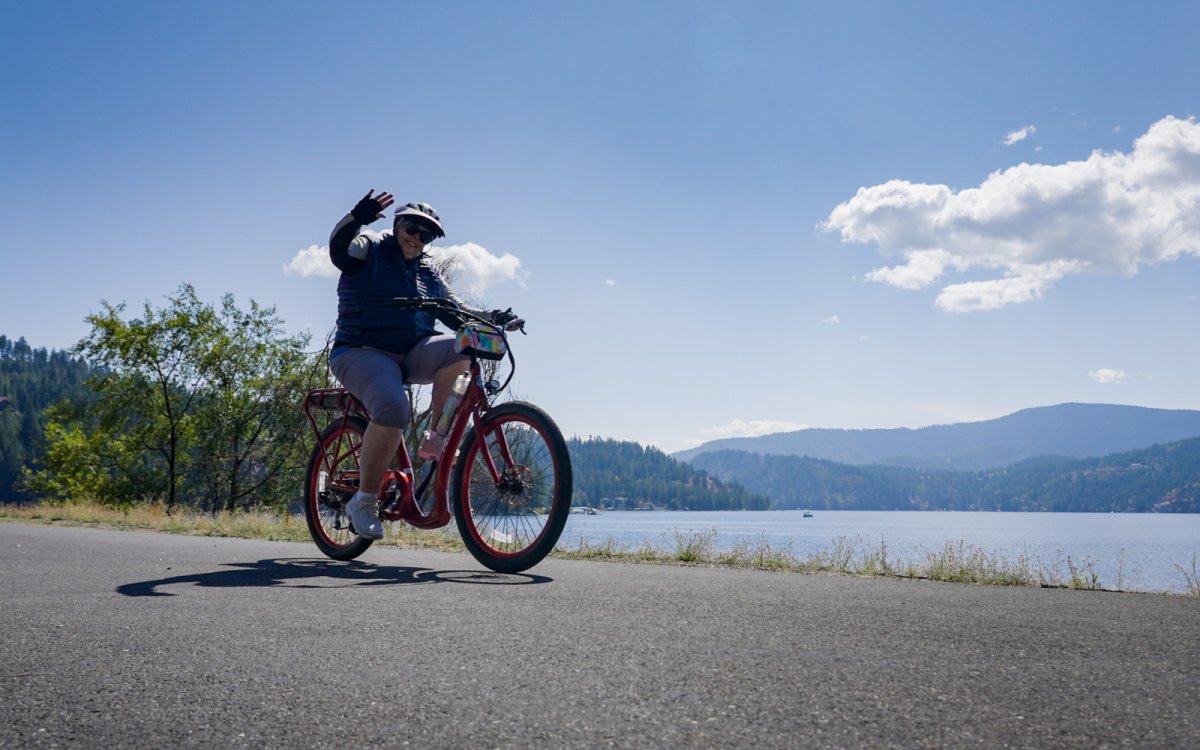Wilderness Voyageurs Trail of the Coeur Dã¢â‚¬â„¢alenes & Route of the Hiawatha Reviews
Trail of the Coeur d'Alenes
Post-obit the former Wedlock Pacific Railroad from the mining town of Mullan to Plummer, the Trail of the Coeur d'Alenes is a 72-mile paved path through the Silver Valley. Information technology's ane of several projects undertaken by the Rails-to-Trails Salvation to transform the nation's abandoned railways into recreational corridors and is one of the United States' most loved.

Nature, wild animals and small town encounters
Spanning the width of Idaho (from its eastern border with Montana to its western borderland with Washington), the trail roughly follows the banks of the Coeur d'Alene River (after which it is named). It takes in historic towns such as Kellogg, Wallace, and Harrison, as well as the natural wonders of Heyburn State Park and the Palouse prairie. The surrounding marshland offers exceptional wildlife viewing, with sightings of eagles and ospreys regularly recorded, along with moose, elk, and several butterfly species.
Later on winding its way through the mountainous Silver Valley (and then named for its rich mining heritage), the Trail of the Coeur d'Alenes continues along the shores of Lake Coeur d'Alene. It crosses the Chatcolet Bridge before exploring ane of the oldest protected areas in the Pacific Northwest, Heyburn State Park, with its centuries-old Ponderosa pines and wildflower-covered hills. The route concludes with a gentle climb through the rolling hills of the Palouse prairie, which is a major center for the cultivation of wheat and legumes. If yous're feeling energetic, you can continue riding from Plummer along the bike path that leads to the cultural city of Spokane.
At that place are twenty developed trailheads for entering and exiting the Trail of the Coeur d'Alenes, every bit well as 20 scenic waysides with tables where you can picnic or simply rest. In Wallace, you'll find a beautifully restored depot of the Northern Pacific, which is at present operated as a museum. It houses artifacts and rolling stock related to the railway, as well every bit offering a cursory insight into its history.

Gold fever in Idaho's panhandle
Golden and silvery were discovered in Idaho'due south panhandle in 1884, which led to an influx of opportunists hoping to strike it rich. While the gilt deposits were minimal, argent, zinc, and lead all proved to exist lucrative for widespread mining operations. In response, two railways were synthetic to booty the ore and transport mining supplies, likewise equally serve Idaho'southward timber industry. I was the Washington & Idaho Railroad, which was later acquired past the Oregon Railroad & Navigation Company (a subsidiary of the Wedlock Pacific) while the other was the Coeur d'Alene Railway & Navigation Visitor, which would become part of the Northern Pacific system.
The Trail of the Coeur d'Alenes follows what was known equally the Washington & Idaho Railroad, a 154-mile system that was get-go conceived in 1886 to connect Tekoa, Washington with Mullan, Idaho. It later became known as the Wallace Branch and sustained itself by non only hauling lucrative silver and mining deposits but also timber and freight traffic.
After beingness in operation for more than 100 years, the Northern Pacific's successor, Burlington Northern, sold the line between Wallace and Mullan to the Union Pacific. Traffic was steadily failing and by 1991, the entire Wallace Branch was abased.

An innovative ecology solution
When the railway was built, mining waste rock and tailings with heavy metals were used for the bed, which was further contaminated by ore concentrate spillage from passing trains. A lawsuit was filed past the Coeur d'Alene Tribal Council to have the land cleaned up, which was undertaken as a collaborative project between the Environmental Protection Bureau, the State of Idaho, and the Union Pacific.
Today, the trail is managed by the Idaho Section of Parks and Recreation and the Coeur d'Alene Tribe, with a department of the trail extending through the Coeur d'Alene Reservation. The thick cobblestone and gravel barriers are designed to permanently isolate the contaminants and forestall them from spreading to the surrounding environment. Creating the Trail of the Coeur d'Alenes has turned out to be an innovative solution to the environmental deposition caused by years of mining activities and the route has now been recognized by the Rail-Trail Hall of Fame.
With its gentle grade and smooth surface, the Trail of the Coeur d'Alenes is ideal for cyclists of all ages and can be completed on traditional bikes or e-bikes. It is open year-round, with the most easterly stretch of the trail between Wallace and Mullan groomed for snowmobiles, snowshoers, and cross-country skiers in the winter months. Camping facilities and rest areas are conveniently dotted along the road, which is ideal for non merely walkers and cyclists but besides in-line skaters and those in wheelchairs.
The Trail of the Coeur d'Alenes is one of several rail-to-trails routes that can exist explored on a multi-24-hour interval guided tour, with all of the logistics taken care of for you. Knowledgeable local guides will immerse you in the region's fascinating past, too as offering their unique insights into the current land of diplomacy. With shuttles to and from the trailheads included (plus loftier-quality bicycles, accommodation, and meals), all you have to worry almost is enjoying the experience with other, like-minded cyclists. We offer both traditional and due east-bicycle tours of the Trail of the Coeur d'Alenes, as well as the Road of the Hiawatha.
Source: https://www.rowadventures.com/blog/trail-of-the-coeurdalenes
Post a Comment for "Wilderness Voyageurs Trail of the Coeur Dã¢â‚¬â„¢alenes & Route of the Hiawatha Reviews"